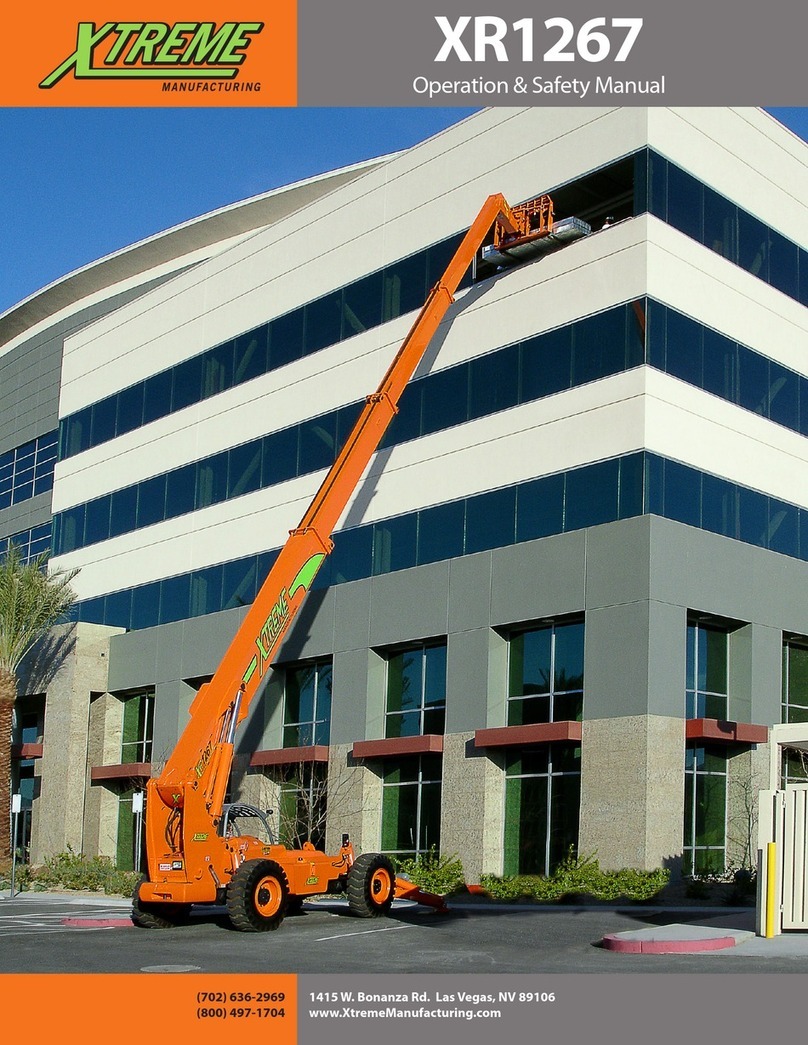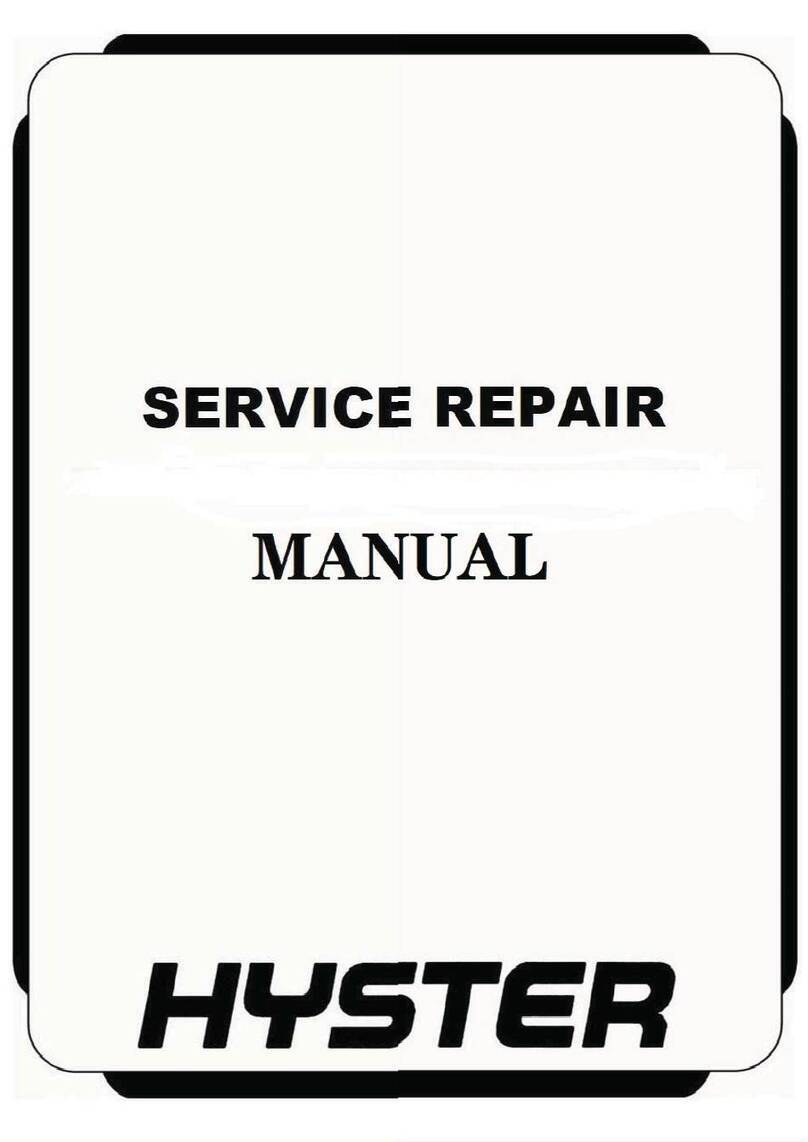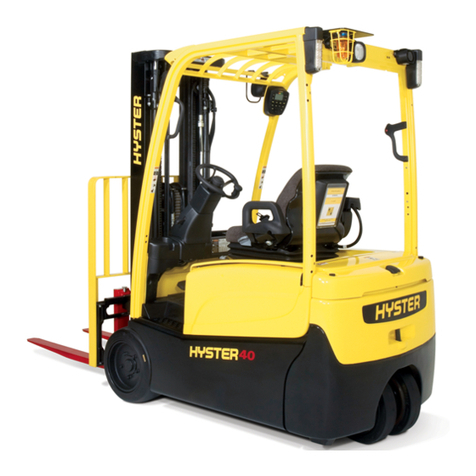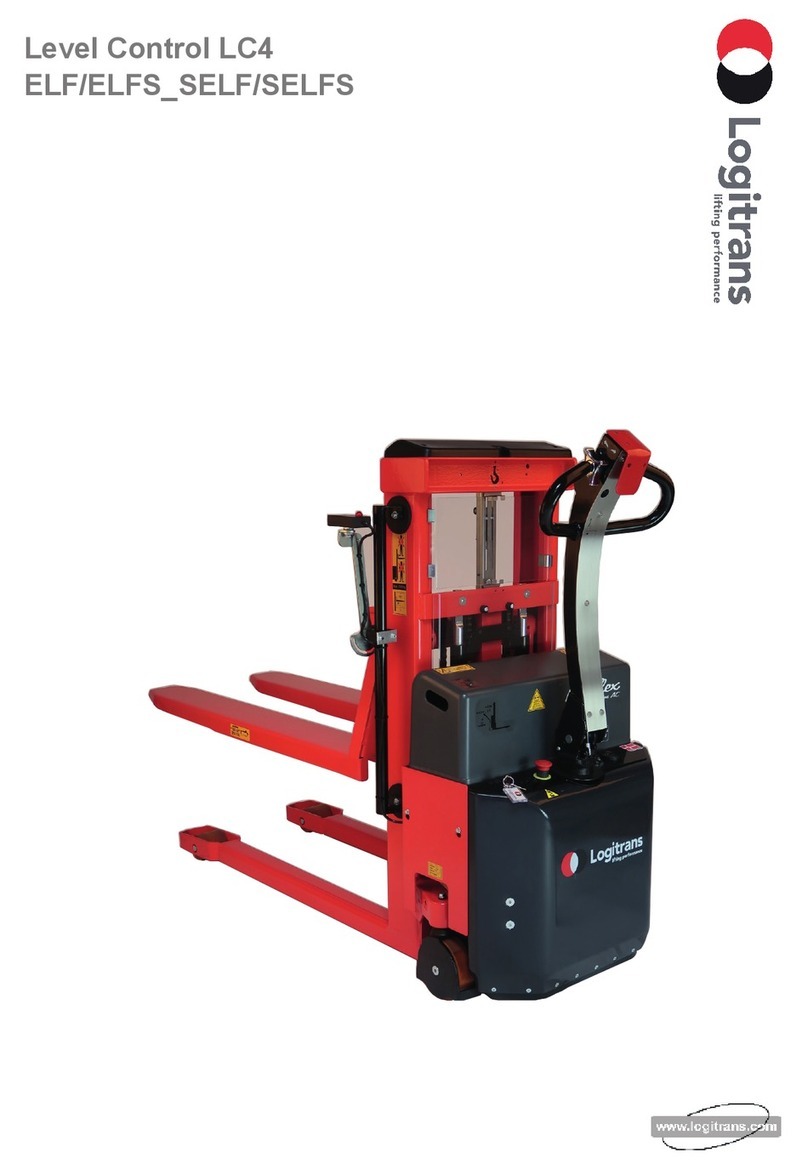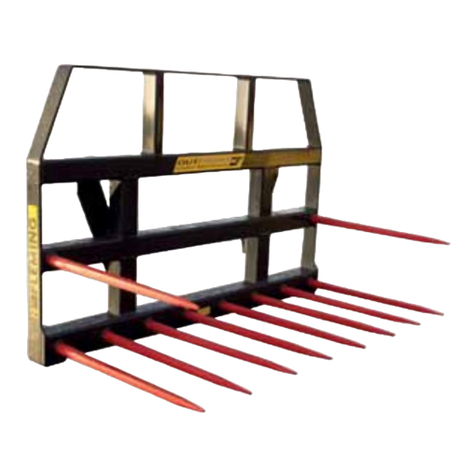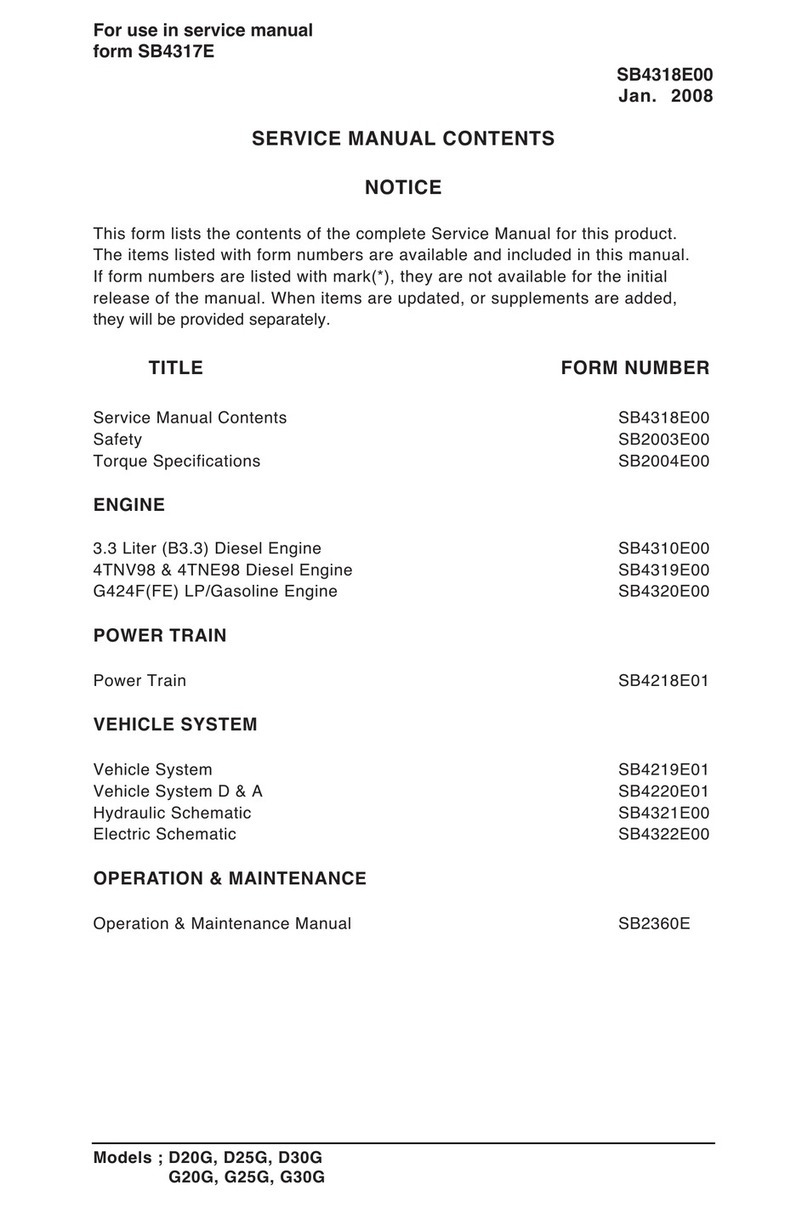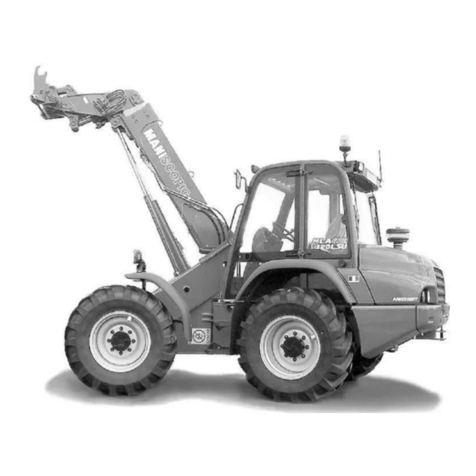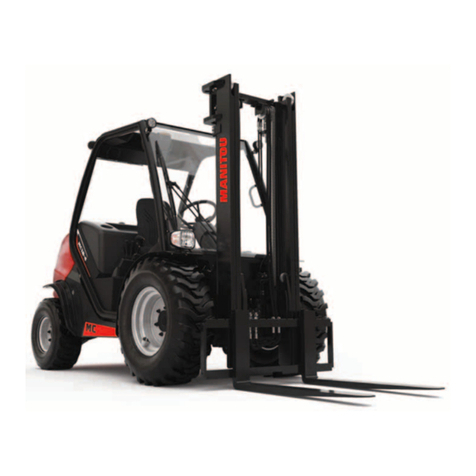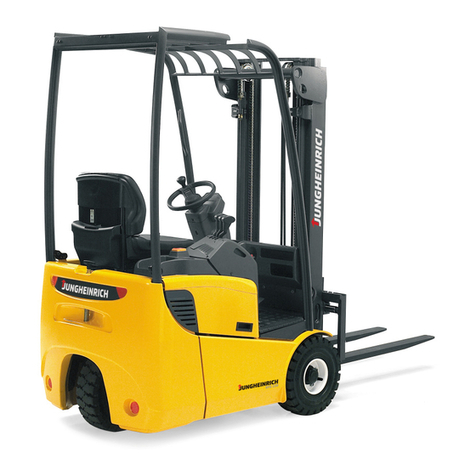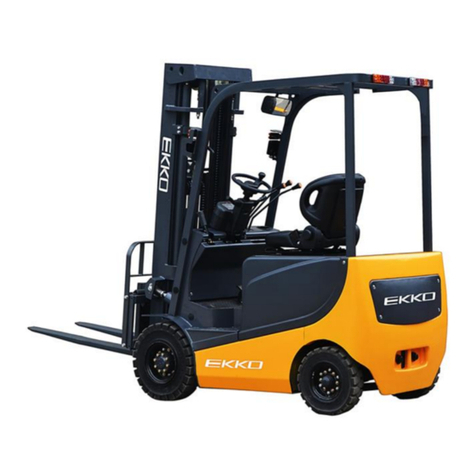HANGCHA XF Series Quick start guide

XF series
OPERATION MANUAL
1.0t-X5.5T XF series Internal Combustion
Counterbalanced Forklift Truck
Operational and
Maintenance Manual
Original Instruction
HANGCHA GROUP CO., LTD
04/2018

I
Foreword
1-x5T XF series internal combustion forklift is a new developed forklift of Hangcha
Group, it owns characteristics as energy conservation and environment protection,
novel structure and superior performance. This manual introduces safety,
operation, transportation, lubrication, brief structure and maintenance method of
trucks. Driver, maintenance personnel and equipment manager must read and
comprehend this manual before use.
Because of the update and improvements of our products, there may be some
differences between this operation manual contents and your forklift truck.
Illustration adopted by this manual may vary from your truck structure.
This manual is also available for container forklift and forklift equipped with
attachment.
Please contact Hangcha Group or your sales agent if you have any questions
regarding this manual.
© 04/2018 HANGCHA GROUP CO., LTD

II
Content
I. General rules·······················································································1
II. Name of main parts or component···························································3
1. Instruments···················································································4
2. Controls and switches·····································································9
3. Truck body and others ··································································14
III. Safety rules······················································································19
IV. Maintenance····················································································24
1. Daily maintenance(8hours)························································24
2. Weekly maintenance(40hours)···················································28
3.Monthly maintenance(166hours)··················································34
4.Every half year maintenance (1000 hours)·········································37
5.Annual maintenance (2000 hours)····················································39
6.Others························································································40
V. Structure and stability of truck ······························································43
VI. Operation························································································45
1. Start-up······················································································45
2. Travel························································································45
3. Pick up ······················································································46
4. Stacking load ··············································································46
5. Remove load ··············································································47
VII. Parking··························································································48
1. Parking daily···············································································48
2. Park the truck for a long time··························································48
3. Running after storing for a long time ················································49
VIII. Maintenance ··················································································50
1. Preventive maintenance schedule···················································50
2. Torque Specifications····································································59
3. Periodic replacement of key safe parts·············································60
4. Table for the oil used in the truck·····················································61
5. Lubrication system drawing····························································65
IX. Labels:Stick various nameplate and mark at different position of the truck ·66
X. Truck transporting, lifting, towing ··························································72
XI. Model meaning ················································································73
XII. Main technical performance parameter ················································79
XIII. Cab and overhead guard································································ 109
XIV. Operation and notice about LPG forklift············································· 114

III
XV. Operational method of lead acid battery············································· 125
XVI. Use, installation and safety rules of attachment ·································· 129
XVII. Description of OPS System···························································· 131
XVIII. Relevant safety command and standard·········································· 133
XVI.Maintenance record ······································································· 137

1
I. General rules
To keep the truck and you safe, obey these rules below:
1. Only trained and authorized operators shall be permitted to operate the truck.
2. Before starting truck you should check all control and alarm devices; if any are damaged, DO
NOT operate until it is repaired.
3.When carrying a load, do not overload. The forks should insert in the load completely and evenly.
It is not permitted use only one fork to load.
4. You should operate the truck smoothly when starting, turning, traveling, braking and parking. On
a slick or wet road, decrease speed when turning.
5. Lower the forks and tilt the mast backwards when traveling with a load.
6. If the slope angle is bigger than 10%, travel forward up slope and backward down slope. Never
turn sideways or stack load on an incline.
7. Be aware of bystanders, barriers, potholes and overhead clearances.
8. DO NOT allow passengers or persons to stand on the fork.
9. DO NOT stand or walk under the fork.
10. DO NOT operate the truck or attachment from any position except the operator‘s seat.
11. DO NOT carry the load unpackaged. Be careful when carrying large loads.
12. Take care not to lose load when lift height is higher than 3 meters, take protective measures if
necessary.
13. Travel with load as low as possible and tilt back the mast.
14. When driving over a dock-board or bridge-plate, be careful and drive slowly.
15. Make sure that there is no naked flame near the area, never smoke. The driver should not
remain seated when adding fuel.
16. Treat the truck with attachments as a loaded truck
17. When leave the truck, you should put the forks down, make the shift lever in neutral, shut down
the engine and cut the power. When parking on a grade, make sure to tighten the brake lever. If
necessary, use a block when parking on a grade for a long time.
18. If the truck suddenly gets out of order, or for leakage of electrolyte, hydraulic oil or brake oil
when lifting goods or grade climbing, leave truck in safe state and contact service technician
immediately.
19. During installation and assembly, there will be noise and vibration. Please choose the right tool
and assembly method. Minimize the noise and vibration as soon as possible to reduce noise
pollution.
20. The work road surface for forklift should be stable and free of litter, preferably cement, blacktop
or concrete. If there is snow, ice, water or other eye irritants, protect against these and resume
work.
21. Move the truck to the place where respects traffic when it anchors. If the reason is brake or turn
system, move it by a suitable truck (Refer to the part of truck carrying); other reasons, use a
suitable truck to move, tie the cord outside of truck. Please abide by the traffic regulations when
moving the truck on roads.
22. DO NOT operate the truck or load cargo after removing the hood, water tank cover board,
overhead guard, or load backrest of mast.
23. Make sure there is enough light around the work area. At night, use the head lamps.
24. Handle with automatic pitch fork of the forklift when the load must not make lateral operation, so
as not to lose balance and forklift components of the damage caused.
25. 5-10 t trucks are equipped with energy accumulator, which offers at least one time emergency
braking after engine off. In order to ensure your safety, please carefully read and strictly carry out
relevant accumulator operation.
26. Before hydraulic oil temperature rises, do not tilt the mast forward, backward or lift the mast to
the limit when in idling.
27. No modifications or alterations to a powered industrial truck, which could affect, for example,
capacity, stability or safety requirements of the truck, shall be made without the prior written
approval of the original truck manufacturer, its authorized representative, or a successor thereof.

2
This includes changes affecting, for example, braking, steering, visibility and the addition of
removable attachments. When the manufacturer or his successor approves a modification or
alteration, the manufacturer or successor shall also make and approve appropriate changes to
the capacity plate, decals, tags and operation and maintenance handbooks.
28. In the event the truck manufacturer is no longer in business and there is no successor in the
interest to the business, the user may arrange for a modification or alteration to a powered
industrial truck manufacturer and the user shall:
(1) Arrange for the modification or alteration to be designed, tested and implemented by an
engineer(s) expert in industrial trucks and their safety;
(2) Maintain a permanent record of the design, test(s) and implementation of the modification or
alteration;
(3) Approve and make appropriate changes to the capacity plate(s),decals, tags and instruction
handbook;
(4) Affix a permanent and readily visible label to the truck stating the manner in which the truck
has been modified or altered together with the date of the modification or alteration, and the
name and address of the organization that made the modification or alteration.

3
II. Name of main parts or component
1. Fork
2. Load backrest
3. Tilt cylinder
4.Mast
5.Lift cylinder
6. Steering wheel
7. Overhead guard
8. Seat
9. Cover hood
10. Counterbalance weight
11. Rear wheel
12. Truck frame
13. Front wheel

4
1. Instruments
1.0t-3.5t forklift (Except W43)instrument LCD
4.0t-x5.5t W34,W35 forklift instrument LCD
A.Water temperature gauge
B.Fuel gauge
C.Timer
D.Accumulator warning indicator
E. Neutral position start-up
indicator
F. OPS indicator
G.Transmission oil temperature
warning light
H. Parking indicator
I. Preheat indicator light
J. Oil water seperator Indicator light
K.Engine oil pressure warning light
L. Charging indicator light
M. Left turning indicator
N. Right turning indicator
1.0t-3.5t W43 forklift instrument LCD
A. Water temperature gauge
B.Fuel gauge
C.Timer
E. Neutral position start-up
indicator
F. OPS indicator
G. Transmission oil temperature
warning light
H. Parking indicator
I. Preheat indicator light
K. Engine oil pressure warning light
L. Charging indicator light
M. Left turning indicator
N. Right turning indicator
P. Engine fault indicator
Q. Severe warning indicator

5
4.0t-x5.5t W58 forklift instrument LCD
4.0t-x5.5t W57,W24,W68 forklift instrument LCD
A. Water temperature gauge
B.Fuel gauge
C.Timer
E. Neutral position start-up
indicator
G. Transmission oil temperature
warning light
H. Parking indicator
I. Preheat indicator light
K. Engine oil pressure warning light
L. Charging indicator light
M. Left turning indicator
N. Right turning indicator
O. Air filter indicator
P. Engine fault indicator
Q. Severe warning indicator

6
Instrument of the state shown in Figure
Water temperature gauge [A]
This gauge indicates the oil temperature in
the torque converter transmission box when
the key is at ┃(ON) position. In normal status,
LED Displayed in the range of 40 ℃-110 ℃
Caution
If LCD display in the red zone , please stop the
truck at once. Decrease the engine speed to
make the engine cool. Check the cooling fluid if
enough and the fan belt‘s elasticity if fit.
Fuel gauge [B]
The gauge indicates the fuel level in the tank
when the key is at ┃(ON) position.
Suggest filling up the fuel tank after work
every day.

7
Hour meter [C]
This meter measures working time of engine
when the key is at ┃(ON) position. The meter
increase one number every working hour.
Use meter to schedule lubrication and
maintenance periods.
Accumulator warning indicator [D]
This indicator light does not work on the
forklift.
Neutral position start-up indicator [E]
Put the steering handle in the neutral position
when truck on the temporarily stop, the light
will indicated on
The truck can be started up only in the neutral
position.
It‘s prohibited for truck in the neutral position
sliping when it‘s on the slope.
OPS indicator [F]
When this light is on, it means driver leave the
seats or not sitting on the seat correctly.
Transmission oil temperature warning
light [G] (Hydraulic Forklift)
In normal state, once the starter is set to
―ON‖ position, this lamp lights up. After the
engine is started up, it goes out.
During work time if the oil temperature exceed
the normal rang(60~120。C) the indicator light
on.
Caution
If the pointer enters the red range, stop the
operation instantly and slow down engine
speed to cool the coolant and wait until the
pointer goes into the green range, and have
a check then.
Parking indicator [H]
Parking indicator shows on means brake is
affected, Please loosen the parking handle
(hand brake handle), the parking indicator will
shows off.
Warning
It will damage the engine and
transmission, etc. when indicated.
Glow indicator (I) [Diesel truck]
Turn the key to ―ON‖ position and the
indicator lights up for a moment. After the
indicator goes out, turn the key to . ―Start‖
position
Sedimentor indicator (J) [W10,W55,W56
diesel truck]
In normal state, once the starter is set to
―ON‖ position, this lamp lights up. After the
engine is started up, it goes out.
This lamp lights up when water in sedimentor
reaches to a certain level, while the engine is
running.
If this lamp continues to stay lit or lights up
during the engine running, stopping the
engine and discharge water immediately.
Caution
If continue working when the lamp is light.
The fuel injection pump may be damaged.

8
Engine oil pressure alert lamp(K)
This lamp indicates the pressure condition of
engine lube oil. Although it lights up when the
engine switch is set at ―ON‖, once the engine
starts up and the accelerator pedal is pressed,
this lamp goes out.
Caution
If this light continues to stay lit or lights up
during operation, the pressure is lower than
0.05Mpa and should be checked
immediately.
Charging indicator (L)
This lamp indicates the battery condition of
charge. The lamp comes on when the ignition
switch is set at ┃―ON‖, but it goes out as the
engine starts and accelerator pedal is
pressed.
Caution
If the light continues to stay lit or lights up
during operation, the charging rate is low
and should be checked immediately.
Left turning indicator [M]
Right turning indicator [N]
When the truck turns left, the indicator is set
forward, the lamp lights up.
When the truck turns right, the indicator is set
backward, the lamp lights up.
Air filter indicator [O]
When the light is on, it indicates the air inlet
system is blocked, stop the truck and clean
the air filter.
Engine fault indicator [P]
[Electronic-controlled engine]
1.0t-3.5t(ExceptW43Cummins engine): This
indicator does not work.
4.0t-7.0t:PSI engine forklift truck: When the
engine gets out of order, this Indicator will
be on. Please stop and eliminate the failure.
OnlyCummins engine forklift truck :
When this light is on, it means one important
engine working is beyond the prescribed
limits of engine protection calibration, engine
power can be reduced, you must stop and
check.
Severe warning indicator [Q]
[Electronic-controlled engine]
OnlyCummins engine forklift truck:
When this light is on, it indicates the engine is
in severe work condition and the engine
power reduced severely. If condition stays
and starts engine protection shut-down, then
this indicator will flash 30 seconds before
engine shut down to warn the impending
shut-down.

9
2. Controls and switches
1.0t~x5.5t forklift Controls and switches graph
1.Steering wheel
2.Horn
3.Combination switch
4.Key switch
5. Lift control lever
6. Tilt control lever
7. Cup holder
8.Instrument
9. Rocker switch
10. Accelerator pedal
11. Brake pedal
12. Inching pedal
13. Brake fluid tank cap
14.Emergency disconnect switch
15. Parking brake lever
16. Steering wheel adjustment switch
17.Reversing lever

10
Steering wheel [1]
Turn left Turn right
It controls the movement direction of truck.
Rotate counterclockwise, the truck moves to
the left; rotate clockwise, then moves to the
right
Warning
This truck is provided with the power
steering, so heavy hand-wheel operation is
caused when the engine comes to a stall.
To put the power steering in operation
again, restart the engine without delay.
Horn button[2]
Press the button in the center of steering
wheel, the horn will sound.
Combination switch(Turn signal switch/light
switch)[3]
Use this lever which is at the right side of
steering column to indicate the turning
direction of the truck.
Forward-left turn light, N-neutral, Backward-right
turn light
The turn signal lever does not automatically
return to the neutral position unlike general
passenger cars. It must be returned to the
neutral position manually.
Turn on the headlamp and small lamp, turn
this switch, and aim the position line on the
switch knob to the relevant marking on the
switch subject.
Key switch[4]
O(OFF):This is the position at which
the key may be inserted or removed
┃(ON):The electric circuit is closed
with the starter switch at ―┃‖ (ON). After the
engine starts, the key remains in.
(START):When the key is turned to
the position, the starter motor is engaged.
Switch returns to the ―┃‖ position
automatically after starting.
Turn the key to ―┃‖ position, the indicator
light[I] will come on momentarily. After the
indicator light goes out, turn the key to ― ‖
position.
Caution
1. Do not leave the key in the ―┃‖position
when engine is off. Doing so will discharge
battery.
2. Do not turn key to the ― ‖ position when
the engine is running. Doing so may
damage the starter motor.
3. Do not keep key in the ―START‖ position
for more than 5 seconds at a time. Wait
about 2 minutes between attempts.

11
Lift lever [5]
Controls the forks‘ up or down.
Push forward——lowered
Pull backward——lifting
Lifting speed is controlled by tilting backwards
angle of lever and accelerator pedal. The
lowering speed can be controlled by tilting
forwards angle of the lever.
Tilt lever [6]
It is used for forward and backward tilting of
mast.
Push—tilt forward
Pull---tilt backward
The tilting speed is controlled by tilting angle
of the lever and accelerator pedal effort.
Caution
The tilt lock mechanism in the hydraulic
control valve will not allow the mast to tilt
forward while the engine is being shut down,
even if the tilt lever is pushed forward.
Side shift control lever
Used for left shifting and right shifting of the
side shift bracket.
Push forward-move to the left
Pull backward-move to the right
Side shifting speed depends on the tilting
angel of the handle and accelerator control.
Different attachment type has different
working way, so the operator must be familiar
with the operation.
Cup holder[7]
It is in the right side of the instrument. It‘s
designed for the operator to put the cup.
Rocker switch[9]
1 Warning light.:Press backward, the warning
light is on; press forward, the warning light is
off.
2 Rear headlamp switch:Press backward, the
rear headlamp is on; press forward, the rear
headlamp is off.
There may be some difference with the rocker
switch if with cab. Add ventilation, anti-fog or
other functions.

12
Pedal
Accelerator pedal [10]
Depress accelerator pedal to increase speed.
Release pedal to decrease speed.
Brake pedal [11]
Depress the pedal partially to slow vehicle
motion. Depress it fully to bring vehicle to a
stop. Release the pedal to resume vehicle
motion.
Caution
Avoid sudden braking which can cause
vehicle rolling over or cargo falling, and lead
to accidents.
Inching pedal [12]
Depress the pedal partially to decrease
hydraulic oil pressure. Use inching pedal for
forklift loading and unloading, and when slow
speed is required. When pedal is depressed
all the way, forklift will slow to a stop.
Caution
Do not use the inching pedal too much, as it
will cause transmission oil temperature to
rise and the clutch to slip.
Emergency disconnect switch [14]
Press the emergency disconnect switch,
disconnect electrical appliance with battery.
Re-start the truck, pull up the switch.
After shut down, turn off the switch in 30
seconds.
Parking brake lever [15]
Pull lever backward to set the parking brake,
push lever forward to release the parking
brake. Always set parking brake before
leaving the truck.
Caution
In case of brake system doesn‘t work or
there is an emergency, you can tighten this
lever to stop the truck in urgency.
Normally it is prohibited to use parking
brake as service brake.
Steering column tilting angle adjustment
[16]
The tilting angle of the steering wheel is
adjustable to suit individual operators. The
steering column is unlocked by pushing down
the lever at the left side of turning rod, then
adjust the angle suit to the driver, and pull up
the lever to lock.
Caution
a. After stop the truck and pulled up the
hand brake, then adjust steering wheel
angle.
b. After adjustment, pull the steering
wheel to make sure if locked.

13
Reversing lever [17]
It‘s installed on the left of the steering column.
These series forklift trucks are electronic
reversing, push or pull this lever to realize the
following functions:
1.5~3.5t
F
Forward
N
Neutral
R
Reverse
4.0~X5.5t
F2
Forward 2 gear
F1
Forward 1 gear
N
Neutral
R
Reverse
1.5~3.5t
4.0~X5.5t
Before changing travelling direction, step the
brake pedal until the truck completely stops,
then move the lever forward to F1, and move
to F2 through F1; if retreat needed, step the
brake pedal to slow down the truck, move
backward to R1, and then move to R2
through R1.
Caution
Only place the lever in neutral can you
start the engine
Engine malfunction detect switch(Only for
CUMMINS engine)
2.0t-3.5t:W43
4.0t-X5.5t:W58
Fn
Engine detect page turning switch(Only
for CUMMINS engine)
2.0t-3.5t:W43
4.0t-X5.5t:W58
When the engine has something wrong, put
the Key Switch at the position┃(ON),
―Engine detect‖switch at ―Fn‖ or ―ON‖,
Indicator is always on, or Indicator
display fault code by various frequency,
remove the trouble according to fault code.If
there are multi-malfunction,you can watch
other malfunctions by using ―Engine detect
page turning‖.After remove the malfunctions,
, or indicator go out.Put
―Engine detect‖switch at ―OFF‖,Key switch o
(OFF ), start the engine only after
30seconds can.

14
3. Truck body and others
Load backrest
The load backrest improves stabilization
when loading goods. Never use forklift truck
without the load backrest.
seat
1
2
3
4
1: Weight adjustment lever
2: Forward and rearward adjustment lever
3: Backrest angle adjustment lever
4: Armrest adjustment knob
•Weight adjustment on the seat
Pull up the weight adjustment lever and then
move the lever to left or right side horizontally
to adjust the seat to the driver‘s weight where
it‘s comfortable for driving and working.
•Forward and rearward adjustment of
the seat
Move the lever to inner side with hands, and
then move the seat assembly forward or
rearward to adjust the seat to a proper
position. When the handle is released, the
seat will be locked automatically.
•Angle adjustment of foldable seat
backrest
When seated on a seat, lay the back on the
seat backrest and pull the backrest angle
adjustment lever upward with left hand. Do
not release the lever until a proper position is
fitted to the seat by moving the body forward
or backward.
•Armrest Adjustment
The inclination of the armrests can be
modified by turning the adjustment knob.
When turning the knob to the outside the
front part of the armrest will be lifting, when
turning the knob to inside it will be lowered.
Warning
Turn off the key before adjusting the
seat.
It‘s prohibited to adjust the position of
the seat only when the truck stops.
In case of accident,
no seat adjustment is allowed in the
process of travelling
Make sure the lever is moved
completely to separate the seat
structure before the
forward and rearward adjustment of th
e seat and angle
adjustment of seat backrest.
After adjustment, each lever should
be back in place. Before using the tru
ck, make sure the lock of every part is
reliable.
Safety belt
·Fasten safety belt
Belt was huddled up in the box. There is a
secondary action to draw out the belt. So you
may meet some trouble due to not be familiar
with it.
One kind of seat: this needs to press the
white circular button (with the words: press to
release) by one hand, then the belt can be
pulled out by the other hand and inserted into
the socket.
You may also meet another seat: the belt box
is adjustable. Rotate the belt box forward, the
belt can not be drawn out. Rotate the belt box
backward, the belt is drawn out. Insert the belt
into the socket of the other side. Rotate the
belt box forward again and then the belt is in
normal working position.
Please fasten the belt when get on the truck.
Meanwhile, let the back and waist close to the
seat. Don‘t tie the seat in the abdomen.
Please don‘t have the seat backrest tilted
excessively. Otherwise, the belt can not be

15
extended correctly.
Prohibit use the belt knotted or twisted.
To tie the belt in the daily operation will
protect you when the truck turn over and
reduce the harm.
·Unfasten the belt
Use left pollex to press the red button (with
the word PRESS) in the socket, it‘s untied.
·Check the belt
Regularly check the bolt of the fixed belt if it
becomes loosened. Don‘t put the belt in the
hard or frangible objects and prevent from
grinding with the sharp blade to avoid any
damage. It is prohibited to remove any parts
of the belt. The belt, used frequently, often
needs to be checked.
cut or frayed straps.
worn or damaged hardware, including
anchor points.
buckle or retractor malfunction.
loose stitching.
If find it abnormal, please change the new belt
immediately. The service life of the belt is
three years, so reject it in advance if it‘s
abnormal.
Overhead guard
DO NOT operate forklift without the overhead
guard. It is designed to protect the operator
from falling objects and meets the safety
standard.
Lock components
To avoid opening the hood at discretion, the
truck is equipped with lock. Use the key to
open the hood.
Hood
The hood can be swung up fully to provide
easy maintenance service. You can lift up the
hood with little effort with an aid of hood
damper.
1
2
WARNING
To lock the hood, press the red button on the
air spring pipe. The lock button is unstuck this
time, then push down the button on the front
of hood until you hear a rattling sound. It
means the hood is locked.
Caution
The hood needs key to open of CE truck.
Turn the key to horizontal position,
and then press the key forward to open
hood.
Use caution not to catch your fingers in the
hood while closing it.
Warning
While performing maintenance under the
hood, the engine must be off to avoid injury to
hands or other body parts. The engine can be
running in order to troubleshoot some
problems, however, DO NOT place body
under hood while it is running.
Before opening hood, please move steering
wheel forward, tilt seat back forward.
After closing hood, reset steering wheel and
seat back to their initial position.
②
①
Radiator cover hood
When the engine cover is closed, this radiator

16
cover hood can be removed to check cooling
liquid.
Caution
Reinstall the radiator cover hood and
tighten the bolt by hand.
Fix up this part by inner hexagon bolts for
truck exported to Europe. Use socket
spanner to loose before remove; reinstall and
tighten the bolt by socket spanner.
Radiator cap and coolant reservoir
The reservoir is located inside the hood.
The radiator cap is located under the cover
plate at the rear of the hood.
Warning
·When the water temperature of the
engine is higher than 70 degrees
Celsius, do not open the pressure cap
of the radiator. Loosen cap slowly to
allow steam to escape. After that,
tighten cap securely. It is good practice
to use a thick waste cloth or the like
when removing the cap.
·Do not wear gloves when removing
radiator cap.
·Antifreeze is harmful to a person, if
swallowed, seek medical advice
immediately. Keep antifreeze away from
children.
Fork stopper
Use it to adjust fork spacing. Pull up fork
stopper, turn 180°, adjust fork spacing
depending on the load to handle.
1
2
3
Warning
The forks should be set
symmetrically to machine centerline and
fork stoppers should always be set
The lower beams of the fork have an
opening section to load or unload forks.
DO NOT set the forks over the
opening. Check the bolt at the middle of
the fork bracket used to prevent fork load
at the opening.
Safety step and safety grip
Safety steps are provided on both sides of the
truck body. The safety grip is located on the
left and right sides of the overhead guard.
Use both the safety step and safety grip when
mounting and dismounting the truck.
Hydraulic fluid reservoir cap
The hydraulic fluid reservoir cap is located on
the right side of the hood. Open the engine
hood when adding oil. Fill hydraulic fluid
through this filler port and lock the cap after
filling hydraulic fluid.
Other manuals for XF Series
1
This manual suits for next models
1
Table of contents
Other HANGCHA Forklift manuals

HANGCHA
HANGCHA XF Series User manual
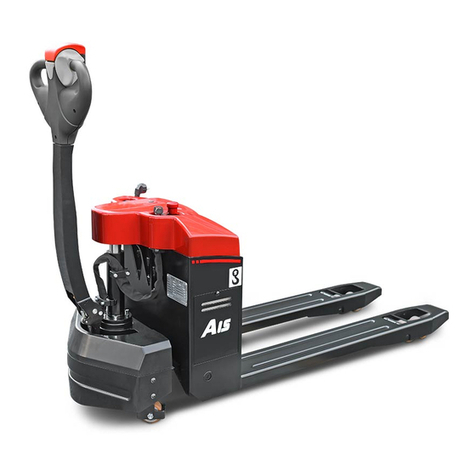
HANGCHA
HANGCHA CBD15-A2MC1 User manual
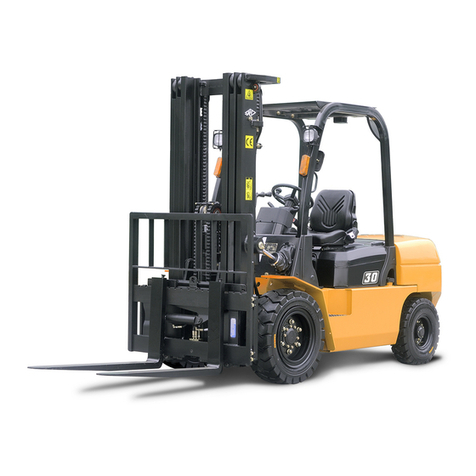
HANGCHA
HANGCHA R Series User manual
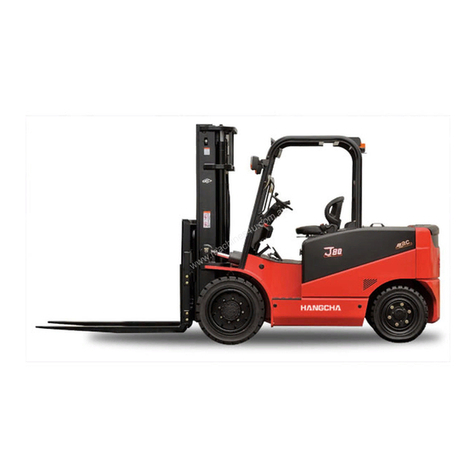
HANGCHA
HANGCHA J Series User manual
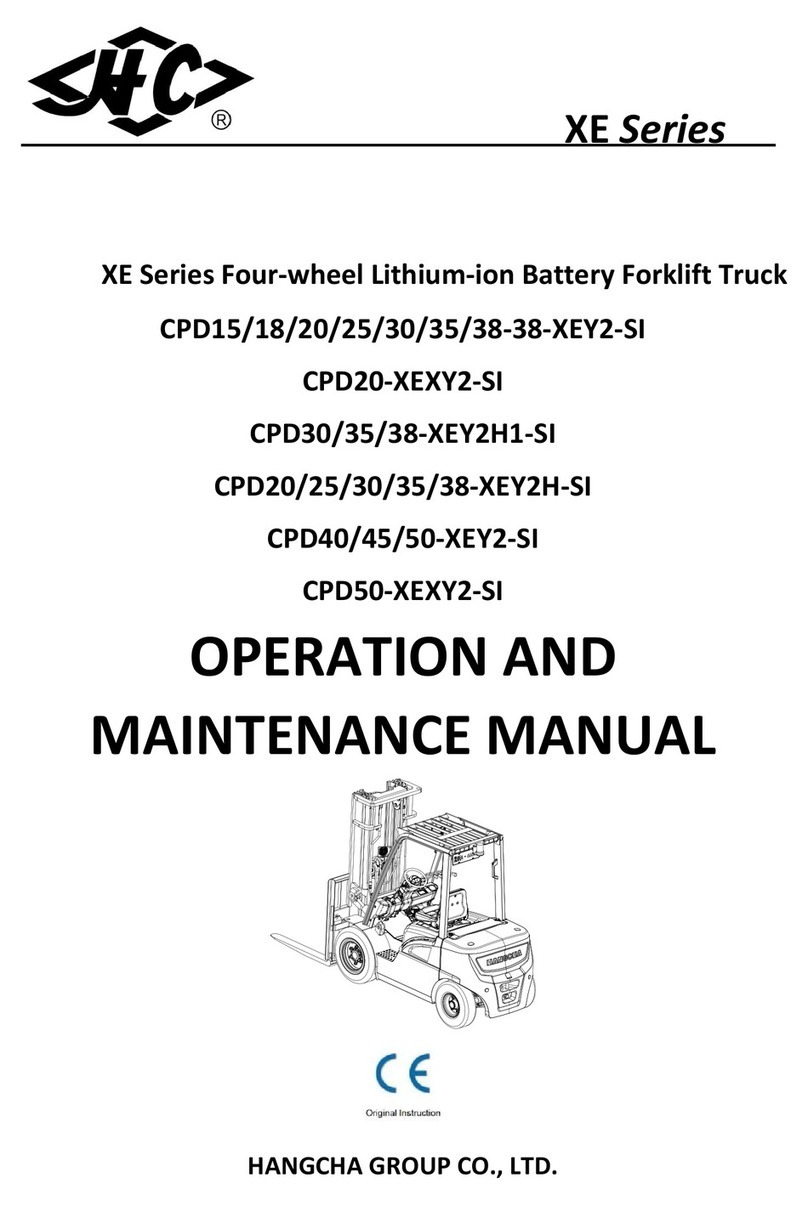
HANGCHA
HANGCHA XE Series User manual
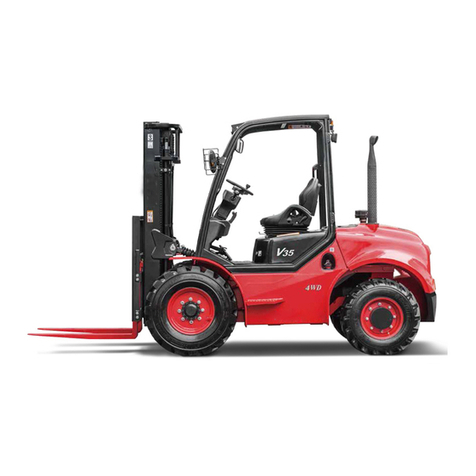
HANGCHA
HANGCHA CPCD30/35-XW43E-RT Quick start guide
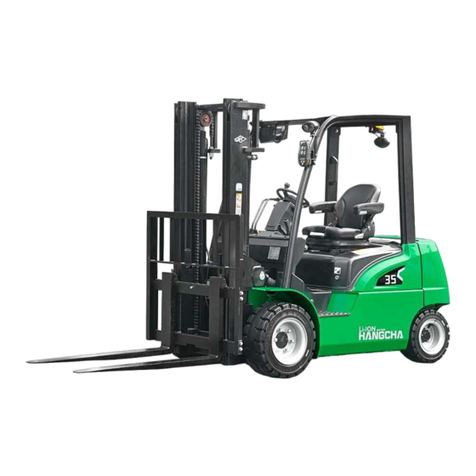
HANGCHA
HANGCHA XC Series User manual
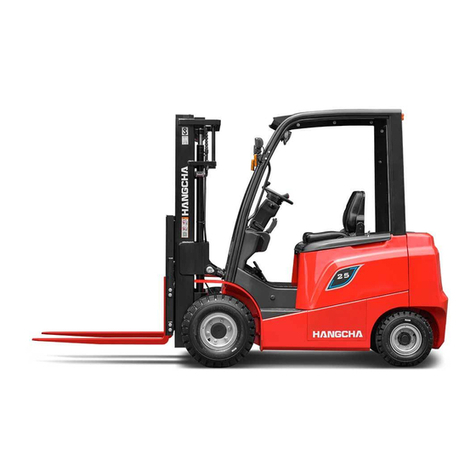
HANGCHA
HANGCHA CPD10-A User manual

HANGCHA
HANGCHA CBD20-AMC1 Installation guide
